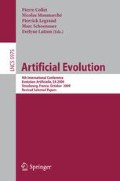Abstract
This paper presents a method to take advantage of artificial evolution in positron emission tomography reconstruction. This imaging technique produces datasets that correspond to the concentration of positron emitters through the patient. Fully 3D tomographic reconstruction requires high computing power and leads to many challenges. Our aim is to reduce the computing cost and produce datasets while retaining the required quality. Our method is based on a coevolution strategy (also called Parisian evolution) named “fly algorithm”. Each fly represents a point of the space and acts as a positron emitter. The final population of flies corresponds to the reconstructed data. Using “marginal evaluation”, the fly’s fitness is the positive or negative contribution of this fly to the performance of the population. This is also used to skip the relatively costly step of selection and simplify the evolutionary algorithm.
Access this chapter
Tax calculation will be finalised at checkout
Purchases are for personal use only
Preview
Unable to display preview. Download preview PDF.
References
Badawi, R.D.: Nuclear medicine. Phys. Educ. 36(6), 452–459 (2001)
Bosman, P.A.N., Alderliesten, T.: Evolutionary algorithms for medical simulations: a case study in minimally-invasive vascular interventions. In: Proceedings of the 2005 workshops on Genetic and evolutionary computation (GECCO ’05), pp. 125–132 (2005)
Bousquet, A., Louchet, J., Rocchisani, J.M.: Fully three-dimensional tomographic evolutionary reconstruction in nuclear medicine. In: Monmarché, N., Talbi, E.-G., Collet, P., Schoenauer, M., Lutton, E. (eds.) EA 2007. LNCS, vol. 4926, pp. 231–242. Springer, Heidelberg (2008)
Cagnoni, S., Dobrzeniecki, A.B., Poli, R., Yanch, J.C.: Genetic algorithm-based interactive segmentation of 3D medical images. Image Vision Comput. 17(12), 881–895 (1999)
Fahey, F.H.: Data acquisition in PET imaging. J. Nucl. Med. Technol. 30(2), 39–49 (2002)
Hudson, H.M., Larkin, R.S.: Accelerated image reconstruction using ordered subsets of projection data. IEEE Trans. Med. Imaging 13(4), 601–609 (1994)
Lewitt, R.M., Matej, S.: Overview of methods for image reconstruction from projections in emission computed tomography. Proceedings of IEEE 91(10), 1588–1611 (2003)
Louchet, J.: Stereo analysis using individual evolution strategy. In: Proceedings of the International Conference on Pattern Recognition (ICPR ’00), p. 1908 (2000)
Michael, G.: X-ray computed tomography. Phys. Educ. 36(6), 442–451 (2001)
Olague, G., Cagnoni, S., Lutton, E.: Introduction to the special issue on evolutionary computer vision and image understanding. Pattern Recognit. Lett. 27(11), 1161–1163 (2006)
Pea-Reyes, C., Sipper, M.: Evolutionary computation in medicine: an overview. Artif. Intell. Med. 19(1), 1–23 (2000)
Shepp, L.A., Vardi, Y.: Maximum likelihood reconstruction for emission tomography. IEEE Trans. Med. Imaging 1(2), 113–122 (1982)
Silicon Graphics, Inc.: Standard template library programmer’s guide, http://www.sgi.com/tech/stl/
Townsend, D.W.: Physical principles and technology of clinical PET imaging. Ann. Acad. Med. Singap. 33(2), 133–145 (2004)
Völk, K., Miller, J.F., Smith, S.L.: Multiple network CGP for the classification of mammograms. In: Giacobini, M., et al. (eds.) EvoCOMNET. LNCS, vol. 5484, pp. 405–413. Springer, Heidelberg (2009)
Watt, A.: 3D Computer Graphics, 3rd edn. Addison-Wesley, Reading (2000)
Author information
Authors and Affiliations
Editor information
Editors and Affiliations
Rights and permissions
Copyright information
© 2010 Springer-Verlag Berlin Heidelberg
About this paper
Cite this paper
Vidal, F.P., Lazaro-Ponthus, D., Legoupil, S., Louchet, J., Lutton, É., Rocchisani, JM. (2010). Artificial Evolution for 3D PET Reconstruction. In: Collet, P., Monmarché, N., Legrand, P., Schoenauer, M., Lutton, E. (eds) Artifical Evolution. EA 2009. Lecture Notes in Computer Science, vol 5975. Springer, Berlin, Heidelberg. https://doi.org/10.1007/978-3-642-14156-0_4
Download citation
DOI: https://doi.org/10.1007/978-3-642-14156-0_4
Publisher Name: Springer, Berlin, Heidelberg
Print ISBN: 978-3-642-14155-3
Online ISBN: 978-3-642-14156-0
eBook Packages: Computer ScienceComputer Science (R0)

